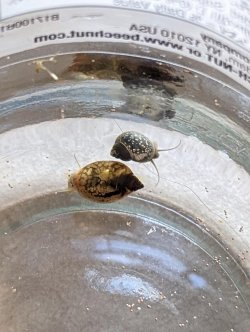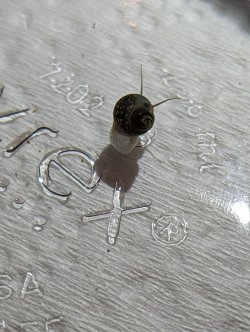ShrimplyTheBest
New Member
I have an established 10 gallon planted tank with 2 golden mystery snails (both male) and 1 nerite snail, and some fish. I recently was setting up 2 new tanks and ordered some plants from Justin's fish tanks to get them set up. I rinsed off the plants, but did not bleach or quarantine them, and the plants went to all 3 tanks. Both new tanks are fully cycled and have some livestock added. The bladder snails showed up first, about a week after setting up the tank and adding plants, and their population continues to explode. A couple weeks later I started noticing some tiny ramshorn. The 2 new tanks have loads of snails (bladder to ramshorn ratio is probably 20:1). There appears to be no bladder or ramshorns in the 10 gallon though.
Then today I see this little guy cruising along the bottom of the 10 gallon. His shell is dextral just like the mystery snail, while the bladder snails are sinistral. When I took him out to scope him out I noticed he also has an operculum. He looks exactly like a mystery snail but I don't know where he came from. Both my golden snails are males (I've witnessed them each mounting), and I've never seen a clutch of eggs laid. One picture is of him alone, and one is him next to a bladder snail for reference.
I'm thinking based on it looking very similar in shape to a mystery snail, having a dextral shell, and an operculum, that this must be in the apple snail family. Either a mystery snail that somehow hitchhiked into the tank on some plants, or an invasive apple snail that did the same.
Then today I see this little guy cruising along the bottom of the 10 gallon. His shell is dextral just like the mystery snail, while the bladder snails are sinistral. When I took him out to scope him out I noticed he also has an operculum. He looks exactly like a mystery snail but I don't know where he came from. Both my golden snails are males (I've witnessed them each mounting), and I've never seen a clutch of eggs laid. One picture is of him alone, and one is him next to a bladder snail for reference.
I'm thinking based on it looking very similar in shape to a mystery snail, having a dextral shell, and an operculum, that this must be in the apple snail family. Either a mystery snail that somehow hitchhiked into the tank on some plants, or an invasive apple snail that did the same.



















